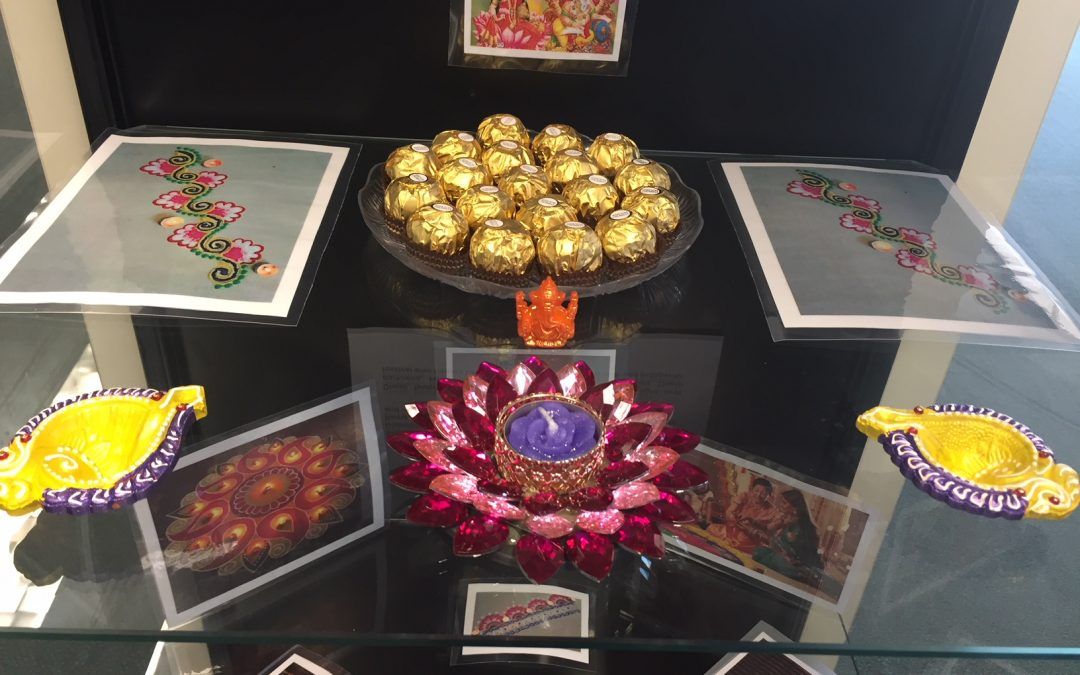
Diwali Display @ Parramatta Heritage Centre
Diwali is a five-day festival of lights, celebrated by millions of Hindus, Sikhs and Jains across the globe. Diwali night is the darkest night of autumn and diyas (lamps), candles, lanterns make the festival of light very memorable. Everyone lights diyas, candle and clay lamp in their home. Diwali is also a festival of sounds and sights of fireworks. Rangoli is a creative colourful floor design made at the entrance of the house. Diwali brings family and friends together every year for the celebrations.
Diwali is celebrated to honor Lord Rama Chandra. Lord Rama is the incarnation of the god Vishnu. On this day Rama returned to his people after 14 years of exile during which he fought and won a battle against the demons and the demon king, Ravana.
Diwali festival celebrates the triumph of good over evil, light over darkness, knowledge over ignorance and hope over despair. Diwali festival also honors Lakshmi, the Hindu goddess of wealth and prosperity.
This year Diwali is on the 19 October 2017. Preparations for Diwali begins weeks in advance. It is a five-day festival. Two days before and two days after Diwali. Each day has significance:
Day 1 – Dhantredas: Dhanteras starts off the five-day festival. Houses and businesses are cleaned, renovated and decorated. Women and girls decorate entrances and walkways of their home, office and temple with Rangoli. Men and boys are busy with external lighting arrangements and buying fireworks for Diwali. This day marks the birthday of Lakshmi – the Goddess of Wealth and Prosperity, and the birthday of Dhanvantari – the God of Health and Healing. On the night of Dhanteras, diyas are ritually kept burning all through the nights in honor of Lakshmi and Dhanvantari. Silver and gold articles are purchased on this day. Lakshmi Puja is performed in the evening.
Day 2 – Naraka Chaturdasi: Narak Chaturdasi is the second day of festivities. The Hindu literature narrates that the asura (demon) Narakasura was killed on this day by Krishna, Satyabhama and Kali. The day is celebrated with early morning religious rituals and festivities follow on. This day is called Choti Diwali. Women and girls decorate their hands with henna designs after preparing homemade sweets for main Diwali.
Day 3 – Lakshmi Pooja: The third day is the main festive day – Diwali. People wear new clothes or their best outfits as the evening approaches. Then diyas are lit and pujas are offered to Goddess Lakshmi. Lakshmi symbolises wealth and prosperity, and her blessings are invoked for a good year ahead.
On Diwali night, Lakshmi is believed to roam the earth. In the evening, people open their doors and windows to welcome Lakshmi, and place diya lights to invite her in. Gifts and sweets are exchanged to mark the importance of relationships and friendships.
After the puja, people go outside and celebrate by lighting up patakhe (fireworks). The fireworks signify the celebration of Diwali as well a way to chase away evil spirits. After fireworks it is time to enjoy the feast and sweets with family.
Diwali also marks the beginning of the new year. Businesses, merchants and shopkeepers close out their old year, and start a new fiscal year with blessings from Lakshmi and other deities.
Day 4 – Balipratipada: The day after Diwali, celebrates the love and mutual devotion between the wife and husband. The husbands give gifts to their wives. Goverdhan puja is also performed in honor of Lord Krishna.
Day 5 – Bhai Dooj: The last day of the festival is called Bhai dooj. It celebrates the sister-brother loving relationship and the lifelong bond between siblings. It is a day when women and girls get together, perform a puja with prayers for the well-being of their brothers.
Neera Sahni, Research Services Leader, City of Parramatta, Parramatta Heritage Centre, 2017


